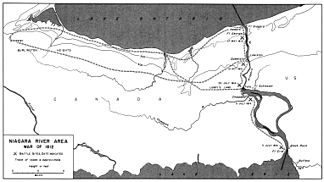Henry Dearborn
[1] When fighting in the American Revolutionary War began, Dearborn fought with the Continental Army as a captain in the 1st and 3rd New Hampshire Regiments; he soon rose to the rank of lieutenant colonel.
[5] At age twenty-three, he organized and led a local militia troop of sixty men to the Boston area, where he fought on June 17, 1775, at the Battle of Bunker Hill as a captain in Colonel John Stark's 1st New Hampshire Regiment.
Later Dearborn would record in his Revolutionary War journal their overall situation and condition: "We were small indeed to think of entering a place like Quebec.
[14] The cautious General Horatio Gates reluctantly ordered a reconnaissance force consisting of Daniel Morgan's Provisional Rifle Corps and Dearborn's light infantry to scout out the Bemis Heights area.
Thereafter Dearborn joined General George Washington's main Continental Army at Valley Forge, Pennsylvania, as a lieutenant colonel, where he spent the winter of 1777–1778.
[16][17] During the American Revolution Dearborn maintained six separate journals where he recorded the various campaigns, battles, and other notable events from his point of experience.
His Revolutionary War journals of Henry Dearborn, 1775-1783, have provided historians of early American history with valuable first-hand information from the perspective of an officer who was engaged in the various battles and surrounding events.
Various scholars have cited the short work as being culturally important and greatly contributing to the knowledge base of early American history.
Dearborn attempted to return to his former congressional seat in 1798[20] and 1800,[21] losing both times to Silas Lee, who had succeeded Parker after one term.
Dearborn also offered the superintendency of the school to Jonathan Williams,[d] who had translated into English some European treatises on artillery and fortification.
Notable among them was Dearborn's report of May 12, 1801 on the War Department,[23] and his recommendation for "designating the boundary line between the United States, and the adjacent British possessions, in such manner as may prevent any disputes in future..."[24] During his tenure, he helped Jefferson form a policy on Native Americans, the goal being to establish a western boundary by procuring lands along the Mississippi River.
Prompted by prevailing rumors of war, Dearborn ordered him to send three companies of troops to Fort Adams in Western Florida as a precaution.
[26][g] In May, Dearborn ordered Wilkinson to the Orleans territory, directing his general to "repel any invasion of the United States east of the Sabine River or north or west of the bounds of what has been called West Florida..." Dearborn further maintained that any such movements across these borders would constitute "an actual invasion of our territorial rights".
This was the opportunity both Burr and Wilkinson were hoping for, thinking that Spanish officials were on edge over the prospect of confrontation with the U.S. and could easily be provoked into war.
When the war broke out he spent even more time in Boston, fearing, as did Vice President Elbridge Gerry, that the Federalists were once again plotting a northeastern secession[j] and ready to install a "Hanoverian"-like monarchy in opposition to them.
[32] Needing to present Congress with reports of progress, Secretary of War William Eustis urged Dearborn to promptly embark for Albany and plan and make preparations for an invasion of Montreal in Canada.
[34][k] On August 9, while General William Hull was expecting a diversionary attack by Dearborn in the Niagara area, the latter was still at his headquarters at Greenbush, just outside of Albany, and was having great difficulty amassing troops for the coming offensive in Canada.
Lacking the means to adequately engage the British in Canada, Dearborn was not eager for battle, welcomed the delay, and rushed news of the armistice to Madison for approval.
[34][35] Dearborn prepared plans for simultaneous assaults on Montreal, Kingston, Fort Niagara, and Amherstburg, but the execution was imperfect.
[36] On April 27, 1813, American forces on Lake Ontario under Dearborn and Commodore Isaac Chauncey gained success at the Battle of York, occupying the town for several days and capturing many guns and stores.
Subsequently, Dearborn accepted an offer from Charles Miner, the editor of The Port Folio, a Philadelphia political magazine, asking him to verify and edit a British soldier's map depicting the Battle of Bunker Hill.
[2][45] Dearborn was later appointed Minister Plenipotentiary to Portugal by President James Monroe, serving from May 7, 1822, until June 30, 1824, when, by his own request, he was recalled.
A U.S. military armory, initially named "Mount Dearborn", was planned in the early 1800s to be built on an island near the confluence of the Catawba and Wateree rivers, adjacent to Great Falls, South Carolina.


